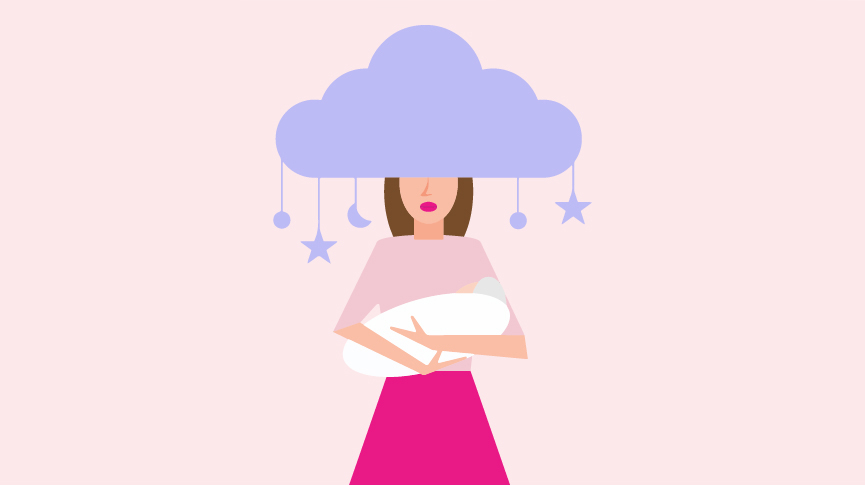5 Suprising Things About Postpartum Depression

The world often sees expecting mothers, and those who recently had a newborn, through rose-tinted lenses. While there certainly is plenty of maternal joy, love, and happy times, for one in ten women (and some men) who suffer from postpartum depression, there can also be many emotional difficulties that come with the postpartum period.
“Baby blues” – which typically include crying spells, mood swings, difficulty sleeping, and anxiety – are experienced by most new moms after childbirth that may begin a few days after delivery and last for up to two weeks.
However, when the “baby blues” last for much longer and becomes more severe, it is known as postpartum depression, or “peripartum depression” if it begun during the pregnancy and continues after childbirth. The most severe form of postpartum depression is postpartum psychosis.
Here are some things to know about postpartum depression so you can have a deeper understanding of the condition and know how or when to seek help.
It’s extremely common
Some studies report that up to 1 in 7 women in the U.S. may experience some form of postpartum depression the first year after giving birth, which may be higher than the traditional 1 in 10 because it accounts for those who are never diagnosed or seek treatment.
Moreover, these statistics only account for postpartum depression in women in live births; many women who have stillbirths or miscarry suffer from postpartum depression symptoms as well. Think about it this way – more new mothers will suffer from postpartum depression each year than men will be diagnosed with cases of impotence this year.
It’s a global phenomenon
Postpartum depression is not limited to the United States, Europe, or the Western world. All around the globe, tens of millions of cases occur, and likely hundreds of millions of women suffer from the condition if statistics were given for all countries. Some statistics compiled by Postpartumdepression.org to consider:
Canada
- 23% of new mothers in Canada reported experiencing postpartum depression or anxiety following childbirth in 2019.
UK
- Around 1 in 10 new mothers in the UK experience postpartum depression
- Around 1 in 8 British women experience antenatal depression (depression during pregnancy)
Philippines
- In 2019, a study reported that at the 6-week mark following delivery, 16.4% of new mothers in the Philippines experienced postpartum depression
Australia
- Unfortunately, around 1 in 5 women in Australia do not receiving proper prenatal and postnatal follow-up screenings, making it difficult to get accurate statistics for postpartum depression, especially for high-risk groups like those with a history of depression.
- Data from the 2010 Australian National Infant Feeding Survey reports that close to 56,000 new mothers were reported to have a PPD diagnosis
Men who have partners with Postpartum Depression may develop depression as well
Some people may find it surprising that postpartum depression isn’t limited to new mothers- men who have partners suffering from PPD, especially more severe forms of PPD, may also develop the condition. There is sadly a lack of awareness surrounding this phenomenon due to the fact that it isn’t as common as PPD in women, leaving the condition often undiagnosed and uncared for.
According to a 2020 Journal of the American Academy of Pediatrics article, nearly 25% of new fathers will suffer from symptoms associated with postpartum depression, but only around 10% of these cases get diagnosed. The term for postpartum depression in men is known as paternal postnatal depression (PPND) or paternal postpartum depression (PPPD).
There may be physical symptoms
When the term postpartum depression comes up, many women only think that it is a mental state. However, our minds and bodies are directly linked, especially after a drastic event such as pregnancy or childbirth.
This means that for some people, PPD is expressed through physical symptoms such as backaches, headaches, nausea, upset stomachs, or panic attacks and fainting.
If you find yourself experiencing the sudden onset of physical aches and pains that don’t have any identifiable sources (not illness, food poisoning, flu), you should speak to your doctor. Although PPD is common, it is not necessarily the norm for all new mothers, and you can seek treatment to help you lead a healthy, happy life.
First-time mothers, younger mothers, and mothers of twins are more at-risk
Recent studies have shown that there are certain groups of new mothers that are more likely to develop PPD. Here’s a breakdown of the most at-risk groups:
- First-time mothers across age groups have significantly higher rates of postpartum depression than women who have previously birthed babies
- Mothers younger than 25 years old (in the study, between 18-24) had higher rates of PPD than older women, with the rates steadily declining as age increases
- Mothers of twins
Researchers from John Hopkins University, the University of Virginia School of Medicine, and Flo Health discovered that mothers older than 40 years old who give birth to twins are at the highest risk of developing the condition.

Clara Wang is a freelance writer based in Nashville, TN but often found abroad. She mostly muses about the three best things in life: Food, sex, and music. Her work has been featured in publications such as Eater Austin, Eater Nashville, Giddy, Buzzfeed, Refinery29, the Austin Chronicle, the Austin American Statesman, and the Daily Dot.


